Physical Address
304 North Cardinal St.
Dorchester Center, MA 02124
Adult bones are classified according to their shape into long (such as femur), flat (such as pelvis), and short (such as bones of hand and feet). Long bones (and some short bones, such as metacarpal bones) are divided topographically into three regions: epiphysis, metaphysis, and diaphysis. The epiphysis, or secondary ossification center, occupies the region of the bone extending from the articular cartilage to the physis. The diaphysis, or shaft of the bone, is separated from the epiphysis by the metaphysis, or primary ossification center. An apophysis is a secondary ossification center on which a tendon or ligament is attached (such as the greater trochanter of the femur). Bone growth occurs at the physis by endochondral ossification, a process by which longitudinal, regularly spaced columns of vascularized cartilage are replaced by bone. At skeletal maturity, endochondral ossification ceases and the physis “closes” by becoming totally ossified. The time of closure of the physis differs in various bones and between sexes. Not only is the physeal region a common site of occurrence for primary bone tumors, but its state of being open or closed influences the extension of pathologic processes in the sense that cartilage is often at least a partial barrier to spreading osteosarcoma. If the physis is closed and cartilage is no longer present, this area is more easily invaded.
Bones are also classified according to their embryologic development. With intramembranous ossification, the bone forms de novo from primitive connective tissue (mainly flat bones). In contrast, with endochondral ossification, the bone formation is preceded by a cartilaginous anlage; this occurs primarily in tubular bones.
Topographically, mature bones have an outer compact layer (cortex, cortical bone, compact bone) and a central spongy region (spongiosa, medulla, cancellous bone). Cortical bone contains vascular channels, which are divided into two types on the basis of their orientation and their relation to the lamellar structure of the surrounding bone: longitudinal (haversian canals) and transverse/oblique (Volkmann canals). Except for the region of the articular cartilage, the cortex is surrounded by the periosteum , which consists of an outer fibrous layer and an inner cellular (cambium) layer of osteoprogenitor cells. The periosteum also contains nerve filaments that carry proprioceptive and sensory impulses; small nerve filaments also may pass with the nutrient vessels into the medullary canal. Coarse bundles of collagenous fibers penetrating the outer compact layer from the outer layer of the periosteum are called Sharpey fibers or perforating fibers.
The periosteum may become detached and elevated from the bone in pathologic processes such as trauma, infection, and neoplasms. When this happens, new bone formation between the elevated periosteum and the bone will occur. This appears by radiographic examination as fine spicules placed perpendicular to the long axis of the bone. This finding is often considered a manifestation of a primary malignant neoplasm, particularly osteosarcoma and Ewing sarcoma. However, periosteal bone proliferation also can occur in a wide variety of neoplastic and non-neoplastic conditions.
An understanding of the blood supply of bone helps to explain the spread and limitation of infection, the healing of fractures, and the involvement of bone by primary or secondary neoplasms. The metaphysis is mainly supplied by end arteries that enter from the diaphysis and terminate at the level of the growth plate. The epiphyses receive their blood supply from a network of widely anastomosing vessels. The diaphyseal cortex is supplied by vessels that enter through Volkmann canals and communicate with the haversian system. A nutrient artery enters the medullary canal near the center of the diaphysis, divides, and extends both distally and proximally. Lymphatic vessels exist in the connective tissue overlying the periosteum, but apparently not in the cortex or medulla.
The constituent cells involved in bone production include osteoblasts and osteocytes. Osteoblasts are bone-producing cells derived from marrow-residing osteoprogenitor cells under direction of the master gene Runx2 . They have a plump appearance and often exhibit a perinuclear halo resulting from a prominent Golgi zone that gives them a plasmacytoid appearance. They have a high cytoplasmic content of alkaline phosphatase and produce RANKL. Ultrastructurally, they resemble fibroblasts by virtue of a well-developed rough endoplasmic reticulum and Golgi apparatus. Indeed, osteoblasts are regarded as a specialized form of fibroblast. Once these are incorporated into the bone matrix and housed in lacunae, they are referred to as osteocytes . SATB2 (special AT-rich sequence-binding protein 2) has been shown to be an excellent marker of osteoblast differentiation, and while not entirely specific for bone-forming neoplasms, it can be useful in distinguishing osteosarcoma from histologic mimics.
Osteoclasts are multinucleated giant cells involved in bone resorption. As such, they typically are found in shallow concavities in the surface of bone called Howship lacunae . Osteoclasts arise from mononuclear monocyte–macrophage precursors. Osteoclasts contain abundant tartrate-resistant acid phosphatase, respond to osteotropic hormones, and contract under the influence of several inhibitors, including calcitonin. Osteoclasts develop from bone marrow stromal cells under the influence of receptor activator of nuclear factor kappa-beta (RANK ligand), which is produced by osteoblasts. Ultrastructurally, the cytoplasm of osteoclasts has a very large number of mitochondria and lysosomes; a ruffled edge is present in the area of the cell membrane that is in the process of bone resorption.
Osteoid is the unmineralized organic precursor matrix of bone. It is composed of a mixture of collagen (mainly type I), acid mucopolysaccharides, and noncollagen proteins. These include osteopontin, osteocalcin, and bone morphogenetic protein. Although only one component of a very complex process, the latter is thought to play a critical role in initiating the process that begins with cartilage resorption and ends with bone formation. Osteoid is not a homogeneous mass but rather shows a constant, patterned sequence of maturation and organization. It has acidophilic properties in hematoxylin–eosin-stained sections, and it may be difficult to distinguish from hyalinized collagen.
Bone is formed through mineralization of the organic matrix of the osteoid. Extracellular matrix vesicles are present at or near the mineralization front and constitute the initial site of hydroxyapatite mineral deposition. In immature woven bone , there is a haphazard arrangement of collagen fibers within the matrix, which is best appreciated with reticulum stains or under polarized light. Lamellar bone is characterized by concentric or parallel lamellae, best appreciated with polarized light. Four types of lamellar bone exist in the skeleton: circumferential, concentric, and interstitial lamellar bone comprise the cortex, while cancellous lamellar bone is found in the medullary cavity.
Bone production can be recognized by the presence of well-stained small spicules of bone with cells in their lacunae and a prominent row of osteoblasts lining their surfaces. New bone formation can be found in a variety of physiologic and pathologic processes, including healing fracture, Paget disease, metaplastic ossification, myositis ossificans, and hyperparathyroidism, among others. However, woven bone in a skeletally mature patient is not normal and indicates an abnormality. Bone resorption (destruction) can be recognized by the presence of numerous osteoclasts in the bone margins and in Howship lacunae. It can involve necrotic bone or viable bone. Molecules thought to regulate the growth plate thickness and bone length through their action on chondrocytes during endochondral ossification are fibroblast growth factor receptor-3, parathyroid hormone (PTH)-related protein, and tartrate-resistant acid phosphatase. The interactions between the various bone cells and bone matrix, as well as bone homeostasis, is a complex system regulated by a variety of factors, including integrins, PTH, calcitonin, 1,25-dihydroxyvitamin D3, and estrogen. Bone remodeling is also a complex process, and bone formation and resorption is regulated by such factors as RANKL, transforming growth factor (TGF)-β, fibroblast growth factor, and bone morphogenetic proteins.
Skeletal substitute material of an increasingly varying nature is being used by orthopedic surgeons to replace or “extend” bone grafts, and these can be found by the pathologist in biopsy and resection specimens in which a previous operation had taken place. Bauer has provided a useful list of these substitutes and the criteria for their recognition.
A thorough discussion of metabolic bone diseases is outside the scope of this chapter. Some metabolic bone diseases will be mentioned briefly, but for a detailed discussion the reader is referred to the books, monographs, and excellent articles that have been written on the subject. Osteoporosis refers to a decreased mass of normally mineralized bone, resulting in microarchitectural deterioration and an increased risk for fractures. It develops when an individual is unable to repair and maintain the mass of bone tissue that has been acquired throughout growth and maturation. Quantitative microradiographic studies have shown that the main difference between the bone in most forms of osteoporosis and normal bone is an increase in the amount of resorption, bone formation levels being generally normal. Osteoporosis occurs frequently after menopause, largely due to deficiencies of estrogen. However, there are many causes of osteoporosis.
Histologic parameters are seldom used to assess for osteoporosis currently, and dual energy/photon x-ray absorptiometry, or DEXA scan, is the gold standard. This radiographic technique compares bone mineral density to a reference population, and a measurement greater than 2.5 standard deviations below the mean is considered osteoporotic. The most common scenario in which pathologists see osteoporotic bone is in fracture specimens, particularly in the proximal femur.
The treatment of osteoporosis is based on medications that slow down bone resorption by inhibiting the formation or activity of osteoclasts, and on those that promote bone formation, such as growth factors and hormones.
Osteomalacia (or rickets in a skeletally immature patient) refers to the accumulation of unmineralized bone matrix resulting from a diminished rate of mineralization. It may be secondary to a wide spectrum of congenital and acquired metabolic abnormalities that result in sufficient decrease in serum calcium, phosphorus, or both to impair mineralization of the skeleton and physeal growth. Some cases have been seen as a complication of bone and soft tissue neoplasms, a phenomenon termed “tumor-induced osteomalacia” (see Chapter 41 ). Osteomalacia changes can be demonstrated in adequate biopsies from long bones and iliac crests with preparation of nondecalcified specimens and examination with bright-field and phase-contrast microscopes and with the use of fluorescent tetracycline markers.
Sophisticated methods of investigating these metabolic bone processes have been devised, but many of them are difficult to implement in the routine pathology laboratory.
Fractures are breaks in the continuity of bone, usually with interruption of periosteum, blood vessels, and sometimes muscles. The speed of return of bone to a normal state following fracture depends on factors such as the age and nutrition of the patient, severity of the fracture, vascularity of the area, and type of treatment. Fractures may fail to heal because of improper immobilization, complete devascularization of the fractured bone segments, persistent infection, and interposition of soft tissue between the ends of the bone.
Following a fracture, a hematoma forms between the two severed ends of bone. Organization of this hematoma begins with the ingrowth of capillaries. Shortly thereafter, bone in the area of the fracture becomes necrotic. Seven to 10 days following the fracture, the hemorrhage becomes more organized, and fibroblastic, chondroid, and osteoid matrix (fracture callus) begin to appear, resulting in a histologic appearance potentially confused for osteosarcoma or chondrosarcoma. Assuming fixation is adequate and the fracture is properly immobilized, the callus is eventually remodeled to normal bone once the fracture has completely healed. The formation and persistence of cartilage largely depend on mechanical factors.
With early proper reduction of the fracture, adequate blood supply, no infection, and normal metabolism, the fracture heals rapidly with little visible callus. Exuberant callus usually means slow fracture healing. In children, even with prominent angulation or deformity, the bone remodels itself to an astonishing degree. For this reason, open reduction and internal fixation of fractures in children are seldom justified. Shortening of a long bone resulting from overriding of fragments will nearly always correct itself in children by overgrowth of bone.
The formation of exuberant cartilage and disorderly woven bone in rapidly forming primary callus results in a bewildering microscopic pattern that may be confused with osteosarcoma or chondrosarcoma. This phenomenon is particularly troubling in osteogenesis imperfecta. The organization and gradual transition between the various components of fracture callus help distinguish it from neoplastic processes.
Bacterial osteomyelitis may be caused by a large variety of microorganisms. About 70%–90% of the cases are due to Staphylococcus aureus ( Fig. 40.1 ). Other common offending organisms include Klebsiella , Pseudomonas , Escherichia coli, Streptococcus , and Salmonella . The latter organism is often involved in the osteomyelitis that affects individuals with abnormal hemoglobin, particularly sickle cell disease. These various organisms gain access to bone via hematogenous spread or through direct extension or inoculation (compound fracture, spread from an adjacent cutaneous ulcer). In skeletally immature patients, the metaphyses of long bones are prone to hematogenously spread osteomyelitis due to intricacies of the vascular supply near the growth plate. The vertebral column is a more common site for osteomyelitis in adult patients.
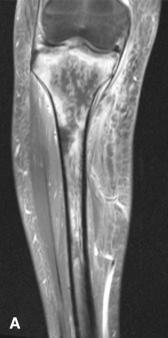
Early after the onset of osteomyelitis, plain radiographs may show vague radiolucency or no changes at all, and at this stage magnetic resonance imaging (MRI) may be necessary to identify the abnormality. However, as the infection evolves, aggressive radiolucent lesions with prominent periosteal reaction can develop which simulate malignant lesions, particularly Ewing sarcoma and lymphoma, prompting biopsy.
Histologically, osteomyelitis can be described as acute, subacute, or chronic. Acute osteomyelitis is characterized by acute inflammation, edema, and bone necrosis. In subacute osteomyelitis, the inflammatory infiltrate contains more lymphocytes and plasma cells, and in chronic osteomyelitis fibrosis and creeping substitution are prominent ( Fig. 40.2 ). When the plasma cell population is particularly prominent, the disease has been designated plasma cell osteomyelitis , and when foamy macrophages are abundant, it has been called xanthogranulomatous osteomyelitis .

In the acute phase, the suppurative component may extend through the cortex into the subperiosteal space. A segment of necrotic cortex trapped in pus is termed a sequestrum . The subperiosteal inflammation stimulates a periosteal reaction surrounding the sequestrum termed an involucrum . A fenestration in the involucrum is referred to as a cloaca . Osteomyelitic sinus tracts in the adult may become lined by squamous epithelium that extends deeply into the bone and becomes discontinuous with the cutaneous surface. Despite apparent healing of the overlying skin, large epidermal inclusion cysts can slowly develop in the underlying bone. These are filled with keratin-containing debris similar to that present in epidermal inclusion cysts of the skin. Rarely, after a long period, squamous cell carcinoma develops within these sinuses. This complication is heralded by the appearance of pain and increasingly malodorous discharge. Chronic osteomyelitis may be accompanied by prominent periosteal bone proliferation.
A Brodie abscess is a localized form of osteomyelitis commonly occurring in the long bones. Imaging studies typically show a circumscribed, radiolucent lesion with surrounding reactive bone that may be mistaken for an osteoid osteoma. Despite a predominance of neutrophils in this lesion, cultures are often negative.
A form of osteomyelitis characterized by recurrent multifocal involvement in children, sometimes associated with palmoplantar pustulosis, has been described (see also SAPHO syndrome); bacterial cultures are negative and the etiology is unknown. Another variant of osteomyelitis characterized by very extensive regenerative bone changes is referred to as Garré sclerosing osteomyelitis. This form is particularly common in the jawbone. It is unclear whether these variants of osteomyelitis are due to an organism or represent rheumatologic conditions.
Tuberculous osteomyelitis has increased in incidence with the AIDS epidemic and in underdeveloped countries and can be seen in children and adults. The bones most often infected are the vertebrae (tuberculous spondylodiscitis, Pott disease), pelvis, knee, ankle, elbow, and wrist. The areas usually involved are the metaphysis, epiphysis, and synovium.
There has been considerable controversy as to which of these areas is the one first involved. Metaphyseal infection is more common in children, and epiphyseal infection is more common in adults; however, with progression of the disease, all zones become affected. Tuberculous granulomatous synovitis destroys the joint and articular cartilage, allowing the inflammation to extend into the epiphysis and finally into the metaphyseal area. If the process begins in the epiphysis, granulomatous tissue quickly extends into the adjacent joint. When the process begins in the metaphyseal area, extension into the joint may be heralded by the development of fluid in it.
Histologically, tuberculous synovitis and osteomyelitis contain the same caseating granulomas seen in pulmonary tuberculosis. The acid-fast organisms may be identified by histochemical stains, but culture and polymerase chain reaction may be necessary for definitive diagnosis. Other causes of granulomatous inflammation in synovium and bone should be considered in the differential diagnosis, such as sarcoid and fungal infections.
Fungal infections of bone include blastomycosis, actinomycosis, histoplasmosis, and coccidioidomycosis. Actinomycosis is particularly common following osteoradionecrosis.
Bone involvement by syphilis most often occurs in congenital and tertiary syphilis but may also be encountered in secondary syphilis. Tertiary syphilis may also lead to neuropathic arthropathy through tabes dorsalis. Both bone destruction and periostitis can occur, resulting in the classic “saber shin” deformity when the tibia is involved ( Fig. 40.3 ). The necrotic, well-defined defects are mainly cortical and periosteal and are surrounded by reactive bone. They may occur in the vertebrae, small bones of the hands and feet, and diaphysis of long tubular bones. Treponemal spirochetes cause microangiitis and obliterative endarteritis, ultimately leading to granuloma-like lesions, or gummas. The spirochetes can be demonstrated by silver stain or by specific immunohistochemical stains.
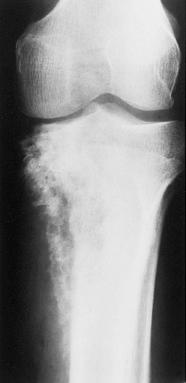
Malakoplakia of bone has been described. As in the bladder and other sites, it probably represents an unusual host reaction to bacterial infection.
Necrotic bone can be recognized by the loss of osteocytes and changes in the marrow, including fat necrosis, fibrosis, and calcification. The histologic changes in the bone are identical regardless of the cause of the necrosis ( Fig. 40.4 ).
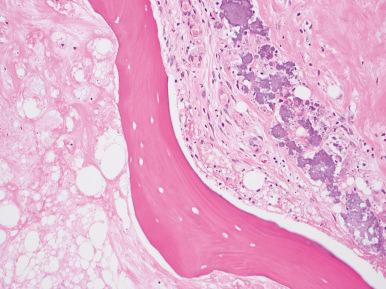
Bone infarct can be the result of a large number of etiologic factors. Radiographically, the changes depend on the age of the lesion and the degree of repair. During the first 1 or 2 weeks, no abnormalities are detected on a plain radiograph. Resorption of the dead bone results in areas of decreased density, whereas new bone formation growing in apposition to necrotic trabeculae (“creeping substitution”) leads to an increase in bone density. The increased bone density is due to both creeping substitution and calcification of the fibrotic marrow space, resulting in a lesion that vaguely resembles an enchondroma radiographically ( Fig. 40.5 ).
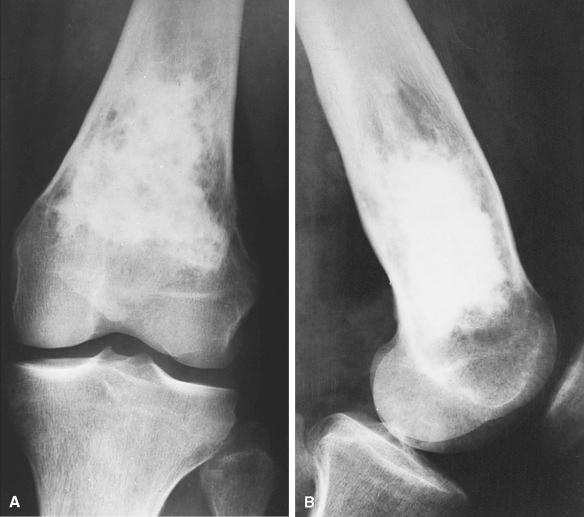
An increased incidence of primary malignant bone tumors has been seen in association with large infarcts of long bones. Most of the reported cases have occurred in the medulla of the femur or tibia of male adults and have been diagnosed as undifferentiated pleomorphic sarcoma, osteosarcoma, “fibrosarcoma,” or angiosarcoma.
Osteonecrosis (avascular/aseptic necrosis) is a common abnormality that has been reported at the ends of virtually all long bones, most commonly the proximal femur and proximal humerus ( Fig. 40.6 ). Many of these sites have been described separately and given eponymic designations such as Legg-Calvé Perthes disease (osteonecrosis of the femoral head in childhood), Kienbock disease (osteonecrosis of the lunate), or Freiburg disease (osteonecrosis of the metatarsal).
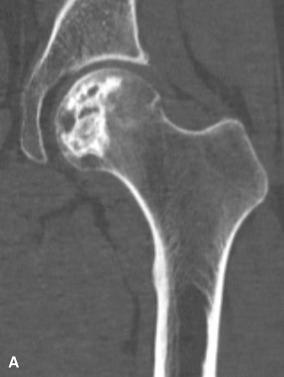
When the blood supply to the involved bone is interrupted, whether intrinsically (thrombosis induced by sickle cell disease) or extrinsically (by fracture or dislocation), an infarct occurs in the subchondral bone. In the femoral head, the area of osteonecrosis appears radiodense, and a “crescent sign” may be present representing separation of the subchondral plate and overlying articular cartilage from the remainder of the bone. Osteonecrosis of the femoral head is mistaken for severe osteoarthritis with some frequency, and the underlying cause may not be recognized until the femoral head is examined pathologically.
Grossly, the necrotic bone of avascular necrosis has a yellow, friable appearance. Often the articular cartilage and subchondral plate are separated from the underlying bone. With collapse, and the onset of secondary arthritis, the infarct may be difficult to identify. Histologically, the well-defined area of osteonecrosis is surrounded by fibrovascular tissue and reactive bone. The interface between the infarct and viable bone is rich in osteoclastic activity, and necrotic bone is eventually replaced by a process referred to as “creeping substitution” in which woven bone is directly deposited onto necrotic bone trabeculae.
Osteochondritis dissecans results from a small area of necrosis involving the articular cartilage and subchondral bone that totally or partially separates from the adjacent structures. The etiology is uncertain but is probably related to trauma in most of the cases. It occurs most frequently on the lateral aspect of the medial femoral condyle, near the intercondylar notch ( Fig. 40.7 ). Microscopically, a portion of articular cartilage is always present, often exhibiting secondary calcification; in addition, a fragment of subchondral bone is found in approximately half of the cases. If this osteocartilaginous fragment remains attached to the joint surface or synovium, both components remain viable. If, instead, it becomes completely detached, its osseous portion dies, but the cartilage remains alive, apparently through nutrients obtained from the synovial fluid, resulting in an osteocartilaginous loose body. Patients with bilateral symmetric involvement and cases with familial incidence have been described.
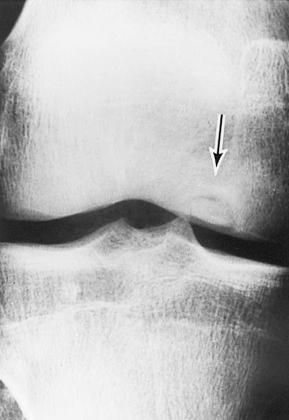
Bisphosphonates and other osteoclast inhibitors, vascular endothelial growth factor (VEGF) inhibitors, and tyrosine kinase inhibitors have all been associated with osteonecrosis of the jaw. The devitalized bone is often accompanied by inflammation and actinomyces, and there may be evidence of bone resorption without accompanying osteoclasts.
Damage to the underlying bone can be a major complication of radiation therapy, whether alone or combined with chemotherapy. Radiation changes resulting in serious complications have been reported in the jaw, ribs, pelvis, spine, humerus, and several other bones. The changes usually occur within 3 years of the therapy. Microscopically, these changes consist of necrotic bone, fibrosis of the bone marrow, and neovascularization. Irregular, heavily staining cement lines may develop and lead to confusion with Paget disease. Radiation necrosis of the jaw can be complicated by actinomycosis, an often underdiagnosed occurrence.
Paget disease is a preneoplastic condition characterized by increased bone turnover, followed by compensatory bone formation. The highest incidence occurs in England, Australia, and western Europe. In an often-quoted autopsy series from England, about one in 30 patients over 40 years of age had Paget disease. The majority of patients with Paget disease are over 55 years of age at diagnosis, and the disease is rare before the age of 40 years. Cases of juvenile Paget disease are described in which patients have osteoprotegerin deficiency. Paget disease affects men slightly more often than women (4 : 3). It can be monostotic or polyostotic, and the most common sites include the pelvis, lumbosacral spine, and craniofacial bones, but long bones are commonly involved as well. Patients with Paget disease are commonly asymptomatic but may present with bone pain, deformities, pathologic fracture, or arthritis.
Radiographically, early Paget lesions are radiolucent, resulting in “osteoporosis circumscripta” in the skull and mimicking a neoplasm in long bones. However, over time the affected bone becomes enlarged, and cortical thickening and coarsening of the trabecular architecture becomes more prominent. During the inactive, terminal phase of Paget disease, the blastic features become even more prominent, resulting in cotton wool-like densities in the skull and bowing deformities of long bones ( Figs. 40.8 and 40.9 ).
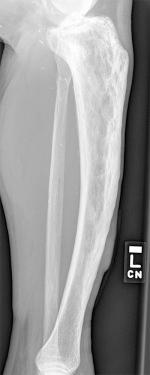
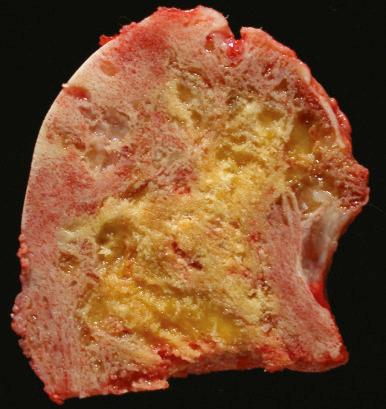
Microscopically, early Paget lesions are characterized by osteoclastic resorption, peritrabecular fibrosis, and prominent vascularity, very similar to what is seen in hyperparathyroidism ( Fig. 40.10 ). During the middle phase of Paget disease, bone formation becomes more prominent. Bone trabeculae tend to be enlarged and irregular, with prominent osteoblastic activity and irregular cement lines. In the final phase of Paget disease, osteoblastic and osteoclastic activity diminishes, leaving markedly thickened, irregular bone trabeculae with prominent “mosaic pattern” cement lines. It is not uncommon to identify all phases of Paget disease simultaneously in a tissue sample. “Mosaic pattern” cement lines are not specific for Paget disease and can be identified in any high turnover condition involving the bone.
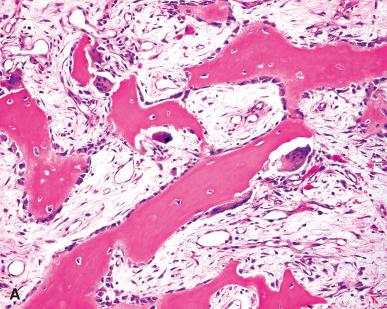
One very important, albeit uncommon, complication of Paget disease is the development of a sarcoma. Osteosarcoma is by far the most common type (about 80% of all cases), but chondrosarcoma, fibrosarcoma, and giant cell tumors have also been observed. Instances of familial or geographic clustering of this complication have been reported. The most common locations of sarcomas arising in Paget disease are the femur, humerus, pelvis, tibia, and skull. Osteosarcoma should be distinguished from the periosteal (juxtacortical) bone masses that can be seen as an exaggerated expression of the basic pathologic process of Paget disease. The prognosis of Paget sarcoma remains very poor.
Proposed etiologies for Paget disease have historically included infectious, environmental, and genetic factors. The suggestion that it might be of viral origin has been raised by the finding of nuclear inclusions resembling paramyxovirus nucleocapsids in the lesional osteoclasts but is unlikely. Mutations in the coding region of the sequestosome 1 (SQSTM1) gene, which produces the p62 protein, are associated with both sporadic and familial Paget disease. Genome-wide association studies have identified other genes also associated with Paget disease.
Osteopetrosis (Albers–Schönberg disease, marble-bone disease) is a group of genetically determined disorders resulting from defects in osteoclast function or development. At least 10 genes have been identified as causative, such as those encoding molecules involved in acidification machinery (e.g., TCIRG1, CLCN7, OSTM1 , and CLCN7 ) and those affecting osteoclast differentiation, which result in the osteoclast-poor form of the disease (e.g., LRP5 , RANKL ).
Microscopically, the disorder is characterized by persistence in the marrow cavity of unresorbed primary spongiosa, with or without alterations in osteoclast number and morphology, depending on the subtype of the disease. Infantile forms of osteopetrosis, generally inherited autosomal recessively, have a poor prognosis, whereas adult forms, generally inherited autosomal dominantly, have a good prognosis but are often complicated by severe arthritis. The disease has been reversed by bone marrow transplantation, and complications such as arthritis and fracture typically require surgical intervention.
The terminology and classification of bone tumors and tumorlike lesions are largely those recommended by the World Health Organization (WHO).
In the WHO classification, neoplasms are classified as either benign, intermediate (locally aggressive or rarely metastasizing), or malignant. In the most recent WHO publication, several entities have been shifted from one of these categories to another. For example, grade 1 chondrosarcoma/atypical cartilaginous neoplasm, while traditionally thought of as “malignant,” is now found in the “intermediate (locally aggressive)” category. Most malignant bone tumors arise de novo, but there are a small number of benign bone lesions that predispose the patient to the development of skeletal malignancies; these include Paget disease, enchondromatosis, osteochondromatosis, and fibrous dysplasia.
Tumors of the skeletal system are relatively constant in their pattern of presentation when one takes into consideration the patient's age and status of the growth plate, the bone involved, the specific area within the bone that is involved (epiphysis, metaphysis, diaphysis, medullary cavity, cortex, bone surface), the radiographic appearance, and the histologic appearance. Table 40.1 should assist in providing a quick orientation for the pathologist confronted with a bone neoplasm.
| TUMOR OR TUMORLIKE LESION | AGE (YR) | GENDER (M:F) | BONES MOST COMMONLY AFFECTED (IN ORDER OF FREQUENCY) | USUAL LOCATION WITHIN LONG BONE | BEHAVIOR |
|---|---|---|---|---|---|
| Osteoma | 40–50 | 2 : 1 | Skull and facial bones | — | Benign |
| Osteoid osteoma | 10–30 | 2 : 1 | Femur, tibia, humerus, hands and feet, vertebrae, fibula | Cortex of metaphysis | Benign |
| Osteoblastoma | 10–30 | 2 : 1 | Vertebrae, tibia, femur, humerus, pelvis, ribs | Medulla of metaphysis | Benign |
| Osteosarcoma | 10–25 | 3 : 2 | Femur, tibia, humerus, pelvis, jaw, fibula | Medulla of metaphysis | Malignant; 20% 5-year survival rate |
| Juxtacortical (parosteal) osteosarcoma | 30–60 | 1 : 1 | Femur, tibia, humerus | Juxtacortical area of metaphysis | Malignant; 80% 5-year survival rate |
| Chondroma | 10–40 | 1 : 1 | Hands and feet, ribs, femur, humerus | Medulla of diaphysis | Benign |
| Osteochondroma | 10–30 | 1 : 1 | Femur, tibia, humerus, pelvis | Cortex of metaphysis | Benign |
| Chondroblastoma | 10–25 | 2 : 1 | Femur, humerus, tibia, feet, pelvis, scapula | Epiphysis, adjacent to cartilage plate | Practically always benign |
| Chondromyxoid fibroma | 10–25 | 1 : 1 | Tibia, femur, feet, pelvis | Metaphysis | Benign |
| Chondrosarcoma | 30–60 | 3 : 1 | Pelvis, ribs, femur, humerus, vertebrae | Central: medulla of diaphysis; peripheral: cortex or periosteum of metaphysis | Malignant. 5-year survival rate: low grade, 78%; moderate grade, 53%; high grade, 22% |
| Mesenchymal chondrosarcoma | 20–60 | 1 : 1 | Ribs, skull and jaw, vertebrae, pelvis | Medulla or cortex of diaphysis | Malignant; extremely poor prognosis |
| Giant cell tumor | 20–40 | 4 : 5 | Femur, tibia, radius | Epiphysis and metaphysis | Potentially malignant; 50% recur; 10% metastasize |
| Ewing sarcoma/PNET | 5–20 | 1 : 2 | Femur, pelvis, tibia, humerus, ribs, fibula | Medulla of diaphysis or metaphysis | Highly malignant; 20%–30% 5-year survival rate in recent series |
| Malignant lymphoma, large cell, and mixed cell types | 30–60 | 1 : 1 | Femur, pelvis, vertebrae, tibia, humerus, jaw, skull, ribs | Medulla of diaphysis or metaphysis | Malignant; 22%–50% 5-year survival rate |
| Plasma cell myeloma | 40–60 | 2 : 1 | Vertebrae, pelvis, ribs, sternum, skull | Medulla of diaphysis, metaphysis, or epiphysis | Malignant; diffuse form uniformly fatal, localized form often controlled with radiation therapy |
| Hemangioma | 20–50 | 1 : 1 | Skull, vertebrae, jaw | Medulla | Benign |
| Desmoplastic fibroma | 20–30 | 1 : 1 | Humerus, tibia, pelvis, jaw, femur, scapula | Metaphysis | Benign |
| Fibrosarcoma | 20–60 | 1 : 1 | Femur, tibia, jaw, humerus | Medulla of metaphysis | Malignant; 28% 5-year survival rate |
| Chordoma | 40–60 | 2 : 1 | Sacrococcygeal, spheno-occipital, cervical vertebrae | — | Malignant; slow course; locally invasive; 48% distant metastases |
| Solitary bone cyst | 10–20 | 3 : 1 | Humerus, femur | Medulla of metaphysis | Benign |
| Aneurysmal bone cyst | 10–20 | 1 : 1 | Vertebrae, flat bones, femur, tibia | Metaphysis | Benign, sometimes secondary to another bone lesion |
| Metaphyseal fibrous defect | 10–20 | 1 : 1 | Tibia, femur, fibula | Metaphysis | Benign |
| Fibrous dysplasia | 10–30 | 3 : 2 | Ribs, femur, tibia, jaw, skull | Medulla of diaphysis or metaphysis | Locally aggressive; rarely complicated by sarcoma |
| Langerhans cell histiocytosis | 5–15 | 3 : 2 | Skull, jaw, humerus, rib, femur | Metaphysis or diaphysis | Benign |
a It should be emphasized that these data correspond to the typical case and should not be taken in an absolute sense. Isolated exceptions to practically every one of these statements have occurred.
Osteoma is seen primarily in the flat bones of the craniofacial skeleton, typically arising from the surface of the involved bone. It may protrude into the orbit or a paranasal sinus (particularly the frontal and ethmoid) and block the normal drainage from these sinuses. Similar lesions, albeit smaller in size, located within the medullary cavity are referred to as enostoses or “bone islands.” Microscopically, osteoma is composed of dense, mature lamellar bone. Occasional cases of sino-orbital osteoma contain foci that closely resemble osteoblastoma ( Fig. 40.11 ).
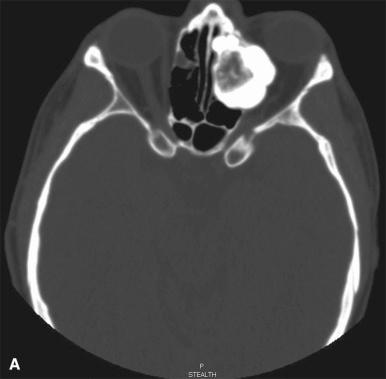
Osteoma is benign and probably not a true neoplasm. Some cases may represent end stages of fibrous dysplasia, related fibro-osseous lesions, or even subperiosteal hematomas. Patients with familial adenomatous polyposis (intestinal polyposis and soft tissue tumors) may have multiple osteomas and other abnormalities, whereas cases of solitary osteoma are usually nonsyndromic. Osteopoikilosis is an autosomal dominant form of sclerosing bone dysplasia characterized by multiple, symmetrically distributed bone islands.
Occasionally, osteomas involve non-craniofacial bones. Most of these have a parosteal location and need to be distinguished from parosteal osteosarcoma.
Osteoid osteoma is a benign bone neoplasm that is found most frequently in patients between 10 and 30 years of age and that exhibits a 2 : 1 male-to-female ratio. Intense pain relieved by nonsteroidal anti-inflammatory drugs is the most prominent symptom; the pain is often sharply localized, more severe at night, and unaccompanied by clinical or laboratory evidence of infection. Vertebral lesions may be associated with scoliosis.
Osteoid osteoma has been reported in practically every bone but occurs most frequently in the femur, tibia, humerus, bones of the hands and feet, vertebrae, and fibula. Lesions of long bones are usually metaphyseal, but they may be epiphyseal and even juxta-/intra-articular (arising within the portion of the bone contained within the joint capsule). Most are centered in the cortex (85%), but they may also occur in the medullary cavity (13%) or subperiosteal region (2%). Vertebral lesions typically affect the posterior elements.
Radiographically, osteoid osteomas contain a radiolucent central nidus smaller than 1.5 cm that may or may not contain a radiodense center ( Fig. 40.12 ). This nidus is surrounded by a peripheral sclerotic reaction that may extend for several centimeters along both sides of the cortex; however, osteoid osteomas arising within the medullary cavity may lack this reaction. The radiographic differential diagnosis includes Brodie abscess, sclerosing osteomyelitis, and stress fracture. Juxta-articular lesions may be mistaken for an inflammatory arthropathy due to the induction of a marked chronic synovitis, and lesions in this location may be better visualized with MRI scans.
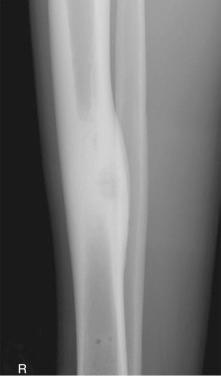
Microscopically, the sharply delineated central nidus is composed of more or less calcified osteoid and woven bone lined by plump osteoblasts and growing within highly vascularized connective tissue, without evidence of inflammation ( Fig. 40.13 ). The appearance is so characteristic that the lesion can still be diagnosed when removed piecemeal. Surrounding the nidus, there is a variably thick layer of dense bone.

The pain associated with osteoid osteoma is characteristically more intense at night, relieved by nonsteroidal anti-inflammatory drugs such as aspirin, and eliminated by removal of the nidus. It has been attributed by some authors to the effect on nerves and vessels of osteoblast-produced prostaglandin E2, which is typically present in large amounts in these lesions. Others believe that the pain is simply related to the presence of entrapped and proliferating nerves within and around the nidus.
CT-guided radiofrequency ablation has largely replaced surgical excision for osteoid osteoma, and proven to be an extremely effective treatment modality for both spinal and extra-spinal tumors. This technique provides excellent pain relief, reduces operative morbidity, and is associated with a low recurrence rate.
Osteoblastoma is a tumor closely related to osteoid osteoma both microscopically and immunohistochemically ( Fig. 40.14 ). It is distinguished from osteoid osteoma by its larger size, the absence or inconspicuousness of a surrounding area of reactive bone formation, and less intense pain. Most cases arise in the medullary cavity of the bone, but cortical and subperiosteal forms also occur. The majority of the cases are located in the spine or major bones of the lower extremity.
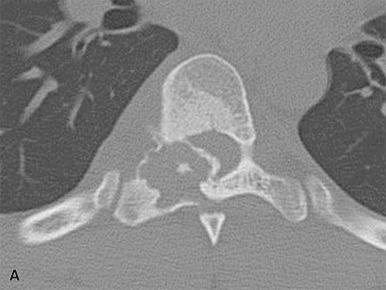
Radiographically, osteoblastomas appear as well-defined radiolucent lesions with haphazardly distributed foci of mineralization. Their size (>2 cm) is larger than osteoid osteoma, and the perilesional reactive bone is typically less pronounced. When osteoblastomas arise in flat bones, they may have radiographic findings that mimic a malignant bone tumor.
Microscopically, the features of osteoblastoma are very similar to the nidus of osteoid osteoma. It is sharply circumscribed from adjacent bone, and those that extend beyond the cortex are encompassed by a thin rim of reactive bone. Anastomosing trabeculae of woven bone prominently lined by osteoblasts are separated by a loose fibrovascular stroma, and multinucleated giant cells may be prominent. A cartilaginous matrix may be encountered in rare cases. The differential diagnosis between osteoblastoma and osteosarcoma can be extremely difficult because the latter may be very well differentiated and the former is sometimes accompanied by the presence of scattered bizarre tumor cells probably of a degenerative nature or may be composed of large epithelioid cells accompanied by telangiectatic features. Permeation of host bone trabeculae should raise suspicion for osteosarcoma, as should foci of necrosis and the presence of mitotic activity. As is the case in many other bone tumors, the radiographic pattern is of great assistance in this differential diagnosis. However, in some cases of osteoblastoma the radiographic picture suggests a malignant neoplasm.
Epithelioid (aggressive) osteoblastoma and related lesions. Some lesions with the radiographic and architectural features of osteoblastoma show atypical cytologic features that some authors believe correlate with a tendency for local recurrence. These tumors have been designated epithelioid (aggressive) osteoblastomas. According to Dorfman and Weiss, these tumors are distinguished microscopically from the ordinary osteoblastomas mainly by the presence of large, epithelioid-appearing osteoblasts, which are at least twice the size of ordinary tumor osteoblasts. They are distinguished from conventional osteosarcomas because of a low mitotic rate and the absence of the following features: lace-like osteoid, permeation of surrounding intertrabecular spaces, and atypical mitoses. The entity “epithelioid multinodular osteoblastoma” is characterized by multiple nodules of epithelioid osteoblasts either lacking bone formation or containing irregular blue-staining osteoid. The entities of epithelioid osteoblastoma, malignant osteoblastoma, pseudoanaplastic osteoblastoma, osteosarcoma resembling osteoblastoma, and osteoblastoma-like osteosarcoma are histologically similar lesions, some of which have been reported to metastasize.
The WHO defines osteosarcoma as a malignant neoplasm in which the neoplastic cells produce bone. It is the most common primary malignant bone tumor, exclusive of hematopoietic malignancies. It usually occurs as a painful mass in patients between 10 and 25 years of age and is exceptionally rare in very young children. A second peak age incidence occurs after 40, usually in association with other preexisting disorders (see the following discussion). There is a slight male predominance (1.5 : 1).
Predisposing factors. Most osteosarcomas arise de novo, but others arise within the context of a preexisting condition:
Paget disease . A high number of osteosarcomas developing in patients over the age of 40 are located in bones affected by Paget disease.
Radiation exposure . One of the classic cases of human carcinogenesis occurred in a group of factory workers in Illinois who developed osteosarcomas from moistening brushes in their mouths when applying radium paint to create luminous numerals on watches. Some cases of osteosarcoma have also been reported years after Thorotrast administration. However, in more recent times, osteosarcoma is known to be a complication of external beam radiation therapy. The average latency period ranges from 10 to 15 years in the various reported series. While many radiotherapy-associated sarcomas of bone are osteosarcomas, many are not classifiable at the microscopic and immunohistochemical level.
Chemotherapy . Children treated with alkylating agents for retinoblastoma and other malignancies have an increased risk of osteosarcoma. Genetic factors probably play an important contributory role.
Preexisting benign bone lesions . These include fibrous dysplasia, bone infarct, and osteogenesis imperfecta (see respective sections).
Foreign bodies . Rare well-documented cases of osteosarcoma have been reported arising at the site of a total hip replacement or at sites of other orthopedic implants.
Genetic predisposition . Patients with Li–Fraumeni syndrome (usually caused by germline mutation of the TP53 gene), hereditary retinoblastoma (caused by germline mutation of the RB1 gene), Rothmund–Thomson syndrome, Werner syndrome, and familial Paget disease have an increased risk of developing osteosarcoma.
Location. Most osteosarcomas arising de novo arise in the metaphyseal area of long bones, particularly the distal femur, the proximal tibia, and the proximal humerus. A few cases arise in the diaphyses and an even smaller number in the epiphyses. Less commonly, osteosarcomas are found in flat bones (such as craniofacial bones, pelvis, and scapula), spine, and short tubular bones. Occasionally, osteosarcomas are multicentric, in either a synchronous or a metachronous fashion: most of these multicentric cases occur in children and tend to be densely sclerotic radiographically and extremely aggressive.
Radiographic features. Conventional osteosarcoma causes destruction of both the medullary cavity and cortical bone, often resulting in an aggressive pattern of periosteal reaction, such as a Codman triangle or a sunburst appearance ( Fig. 40.15 ). The degree and appearance of the mineralization within the tumor depends on the histologic subtype of osteosarcoma and the amount of matrix produced; however, most tumors contain a mixture of radiolucent and matrix-forming foci. MRI is an excellent modality for determining the extent of the tumor in the medullary cavity and soft tissue, and is the study of choice for surgical planning.
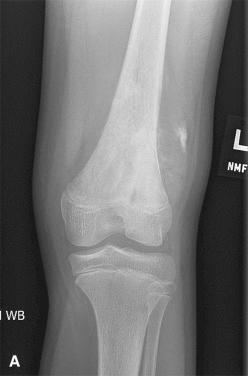
Gross appearance and spread. The gross appearance of the cut surface of an osteosarcoma is highly variable, depending on the histologic subtype and response to neoadjuvant chemotherapy ( Fig. 40.16 ). The range extends from bony hard to cystic, friable, and hemorrhagic.

Osteosarcomas typically arise in the metaphysis and spread longitudinally in the medullary cavity. While the growth plate often acts as a barrier to tumor spread, occasionally osteosarcomas breach the physis and extend into the epiphysis. They invade through the cortex by either directly destroying cortical bone or by invading through the vascular channels in the cortex. When the overlying periosteum becomes irritated, it responds by forming reactive bone, or a periosteal reaction. This typically results in the formation of a Codman triangle, a “hair-on-end” or “sunburst” appearance, or less commonly a lamellated appearance, all of which are visible grossly. The bone underneath a Codman triangle is reactive and does not contain tumor. Osteosarcomas may also extend through the periosteum and into adjacent soft tissues, a feature sometimes seen in the setting of a suboptimal response to chemotherapy. Finally, on rare occasions osteosarcomas may involve the joint or extend across the joint via ligamentous connections such as the anterior cruciate ligament.
Discontinuous foci of tumor within the same bone are defined as a “satellite lesion” when the separate focus occurs within reactive changes around the main mass, and a “skip metastasis” when it occurs outside reactive changes in normal bone and hematopoietic marrow. The prognosis for patients with skip metastases is poor.
Osteosarcomas metastasize through the bloodstream to distant sites, particularly the lung, but they may also metastasize to other bones, the pleura, or other visceral sites. Metastases to regional lymph nodes are extremely uncommon.
Microscopic features. Microscopically, osteosarcoma is defined by the direct production of immature bone or osteoid by neoplastic cells. The most common histologic subtypes of conventional osteosarcoma are osteoblastic, chondroblastic, and fibroblastic, and less common subtypes include giant cell-rich, osteoblastoma-like, epithelioid, clear cell, and chondroblastoma-like. In each of the various subtypes of osteosarcoma, osteoid may be abundant, as in the case of an osteoblastic osteosarcoma, or focal, which is often the case in fibroblastic osteosarcoma. The pattern of osteoid deposition is highly variable, ranging from fine to extremely dense, or “sclerosing.” Osteoid is recognized by its glassy, eosinophilic appearance following decalcification and may be difficult to distinguish from hyalinized collagen. A homogeneous rather than fibrillary appearance, punctate calcification, and a plump appearance of the cells around it are more in keeping with osteoid. The SATB2 immunostain can also be useful in this setting. Occasionally the tumor osteoid appears as thin, tubular, anastomosing “microtrabeculae,” which are very basophilic and vaguely reminiscent of the appearance of fungal hyphae ( Fig. 40.17 ).
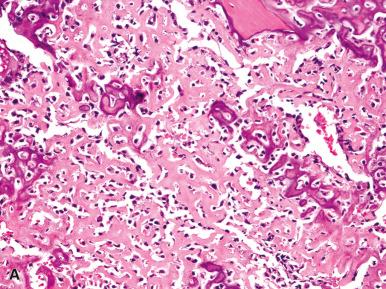
Conventional osteosarcomas are often composed of a mixture of osteoblastic, fibroblastic, and chondroblastic foci, the relative proportions among these three components varying a great deal from case to case. While the predominant component determines which histologic subtype is diagnosed, there is no prognostic significance to this division. The important fact to remember is that a malignant bone tumor should be designated as osteosarcoma whenever osteoid is formed directly by the tumor cells regardless of the predominate stromal cell type.
Morphologic variations in conventional osteosarcoma are plentiful. The osteoid may be sparse or massive, surrounded by pleomorphic, bizarre cells, or relatively acellular and surrounded by tumor cells in a rosettelike configuration (the latter allegedly being a more aggressive variant). The tumor cells may grow in diffuse, nested, or pseudopapillary arrangements. The vessels may be scanty or numerous, sometimes with a dilated or hemangiopericytomatous appearance. The tumor cells may be spindled, oval, or round, and their size may range from small to giant; exceptionally, they have a distinctly epithelial-like appearance. Osteoclast-like multinucleated giant cells are present in many cases and may be so numerous as to simulate a giant cell tumor (so-called giant cell-rich osteosarcoma); the cartilage may be immature, mineralized, or highly myxoid. In the latter instance, the tumor may simulate a chondromyxoid fibroma.
Depending on which one of the previously mentioned microscopic patterns happens to be present, the differential diagnosis of osteosarcoma may include a remarkably high number of benign and malignant lesions, such as fracture callus, fibrous dysplasia, osteoblastoma, “fibrosarcoma,” chondrosarcoma, giant cell tumor, or even metastatic carcinoma. Exuberant fracture callus is particularly likely to be misdiagnosed as osteosarcoma by the unwary, with disastrous consequences for the patient. This callus may be secondary to a pathologic fracture in a benign lesion (such as a metaphyseal fibrous defect or aneurysmal bone cyst), in a metastatic carcinoma, or in osteogenesis imperfecta (where it may be particularly exuberant). Other entities that need to be considered in the differential diagnosis are discussed in connection with the osteosarcoma variants described in the following section.
Histochemical and immunohistochemical features . Osteosarcoma cells usually exhibit strong alkaline phosphatase activity, regardless of their appearance (osteoblastic or other), but the use of histochemistry to detect alkaline phosphatase as a diagnostic tool is highly nonspecific. Likewise, immunohistochemistry has proven to be of limited value in the diagnosis of osteosarcoma due to lack of specificity; however, SATB2 may be useful in establishing osteoblastic lineage in osteosarcoma. An important pitfall in the diagnosis of osteosarcoma is cytokeratin expression.
Molecular genetic features . Osteosarcoma typically shows complex karyotypes, with structural alterations (including translocations) and numerical alterations (gain and loss) involving multiple chromosomes. At the molecular level, alterations of both the TP53 gene and retinoblastoma gene pathways are found in many cases, not unexpectedly since germline mutations in these genes are known to predispose to development of osteosarcoma. The TP53 pathway is altered through loss-of-function mutation in TP53 (50%) and MDM2 amplification (14%–27%). Alterations in other cell cycle genes, such as CDK4 and CDKN2A , are also detected in some osteosarcomas. Deletions and amplifications of chromosomes 3, 6, and 8 result in gene alterations that may have prognostic significance, including LSAMP , RUNX2 , and MYC .
Microscopic variants and special types. In addition to conventional osteosarcoma, the WHO also recognizes other specific variants with characteristics that justify their own category. Many of these osteosarcoma variants simulate other bone processes radiographically and microscopically, and some of them carry distinctive prognostic connotations.
Telangiectatic osteosarcoma . This variant has low-magnification architectural features resulting in an appearance similar to that of aneurysmal bone cyst radiographically and pathologically. Pathologic fractures are very frequent. Telangiectatic osteosarcoma is characterized histologically by numerous blood-filled spaces separated by septa containing highly pleomorphic mononuclear and multinucleated giant cells accompanied by abundant mitotic activity ( Fig. 40.18 ). Telangiectatic osteosarcoma is treated with the same neoadjuvant chemotherapy and surgery as other high-grade osteosarcomas and appears to have a similar prognosis as other conventional osteosarcomas.
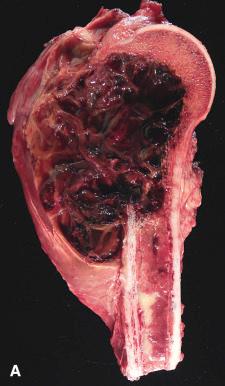
Small cell osteosarcoma . This rare variant of osteosarcoma is composed of small, uniform, round or spindled cells closely simulating the appearance of Ewing sarcoma and malignant lymphoma. The identification of osteoid and the exclusion of other round cell neoplasms with immunohistochemistry or molecular diagnostic testing is necessary for diagnosis. Small cell osteosarcomas are immunoreactive for SATB2 but negative for CD99. Furthermore, small cell osteosarcomas lack any of the Ewing or Ewing-like sarcoma gene fusions. Nevertheless, care must be taken to distinguish this lesion from Ewing sarcoma or related lesions, lymphoma, and mesenchymal chondrosarcoma.
Low-grade central osteosarcoma ( Fig. 40.19 ). This osteosarcoma variant is historically difficult to recognize because of its deceptively bland microscopic appearance and is often underdiagnosed as a benign lesion such as fibrous dysplasia or desmoplastic fibroma. It closely resembles parosteal osteosarcoma. Most patients are adults, and the femur and tibia are the most commonly involved sites; however, other sites, such as the gnathic bones, may be involved. Histologically, low-grade central osteosarcoma is a fibroblastic osteosarcoma with minimal cytologic atypia and minimal mitotic activity. The bone within the lesion may resemble fibrous dysplasia or have a Pagetic appearance. Recurrences are common with inadequate treatment, but metastases are very rare unless the tumor “dedifferentiates.” In contrast to fibrous dysplasia, this tumor shows radiographic evidence of cortical destruction. This feature and the infiltrative growth pattern are helpful in distinguishing this tumor from fibrous dysplasia.
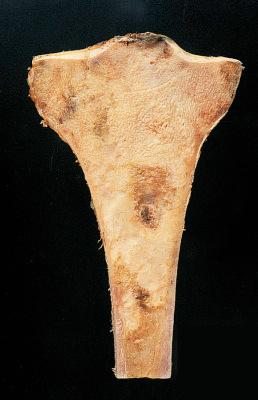
The GNAS1 gene mutation consistently found in fibrous dysplasia is generally absent in low-grade central osteosarcoma, pointing to a different pathogenesis for each of the two processes and providing a tool for their differential diagnosis. Low-grade central osteosarcomas frequently show gain or amplification of MDM2 and12q13-15. Gene amplification can be detected by molecular diagnostic techniques, or MDM2 or CDK4 protein can be detected by immunohistochemistry if only decalcified tissue is available.
Other variants of osteosarcoma are defined on the basis of topographic, clinical, or radiographic features or a combination of them:
Parosteal osteosarcoma . This is the most common surface variant of osteosarcoma. It occurs in a slightly older age group than the conventional variety. It usually arises from the metaphyseal surface of long bones (usually the posterior aspect of the distal femur) and grows very slowly. Eventually, it forms a large lobulated mass with a tendency to encircle the bone ( Fig. 40.20 ) and may penetrate into the medullary cavity, a feature sometimes associated with dedifferentitation. Satellite nodules may be present. Rare cases have been described at other sites, such as the craniofacial bones. The radiographic appearance is highly characteristic.
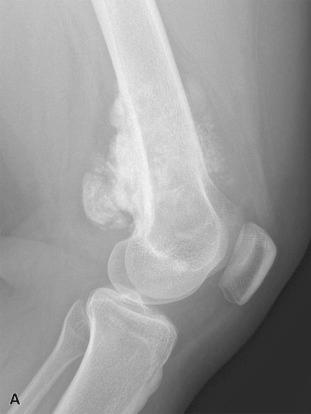
Microscopically, parosteal osteosarcoma closely resembles low-grade central osteosarcoma and is composed of bland fibrous stroma containing disorganized, immature bone ( Fig. 40.21 ). Cartilage may be present on the periphery of the tumor or embedded deep within it. The cytologic signs of malignancy in the fibrous stroma are often subtle, thus accounting for the great frequency of misdiagnoses made in this tumor. Parosteal osteosarcomas are characterized genetically by supernumerary ring chromosomes which contain amplified material from 12q13-15, corresponding to the CDK4 and MDM2 genes, among others. The evaluation of these gene amplifications or detection of their protein products by immunohistochemistry may be useful in distinguishing parosteal osteosarcoma from benign mimics.
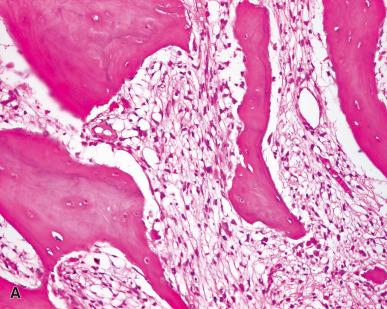
The prognosis for parosteal osteosarcoma is very good, even with segmental excision. It should be emphasized that not all osteosarcomas originating from the bone surface belong to this variety. Those having morphologic features equivalent to those of the conventional intramedullary osteosarcoma are referred to as high-grade surface osteosarcomas and behave as aggressively as the former. Sometimes, features of high-grade osteosarcoma are seen focally in what is otherwise a typical parosteal osteosarcoma, either initially or—more commonly—following repeated tumor recurrences; this phenomenon, which is referred to as “dedifferentiation,” is associated with a markedly decreased survival rate.
Periosteal osteosarcoma. This variant of osteosarcoma, which is very different from parosteal osteosarcoma despite the similarities in the nomenclature, also arises from the surface of long bones. Most of the reported cases have been located in the tibial or femoral diaphysis and have presented as small lenticular lesions on the bone surface accompanied by reactive bone arranged perpendicular to the surface. The lesions are limited to the cortex and only rarely invade the medullary cavity ( Fig. 40.22 ). Microscopically, periosteal osteosarcomas are largely chondroblastic in appearance. The prognosis is better than for conventional osteosarcoma.
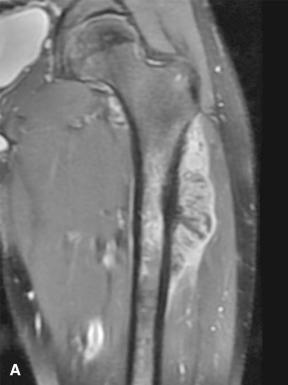
Osteosarcoma of the jaw . Although not technically recognized as an entity in the WHO classification of osteosarcomas, gnathic osteosarcoma is distinctive enough to be discussed individually. Patients affected are slightly older (average age, 34 years), and most lesions show a prominent chondroblastic component ( Fig. 40.23 ). The most common sites of involvement are the body of the mandible and the alveolar ridge of the maxilla. The prognosis is relatively good.
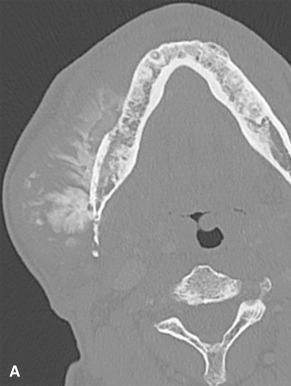
Osteosarcoma in Paget disease . Most cases of Paget osteosarcoma arise in the setting of polyostotic Paget disease. The most common locations are the pelvis, humerus, femur, tibia, and skull. Their prognosis is extremely poor.
Therapy. Formerly, the therapy for osteosarcoma of the extremities typically consisted of amputation or disarticulation, depending on the location of the tumor, and overall survival was less than 20%. Current treatment protocols include neoadjuvant chemotherapy, followed by limb salvage surgery when feasible, and further chemotherapy following resection.
Microscopic studies of the tumor successfully treated with chemotherapy show extensive areas of necrosis and hemorrhage ; sites where viable tumor is more likely to persist are the soft tissue, adjacent to the cortex, and adjacent to the growth plate ( Fig. 40.24 ). The presence of extensive tumor necrosis following chemotherapy constitutes a good prognostic sign (see next section).
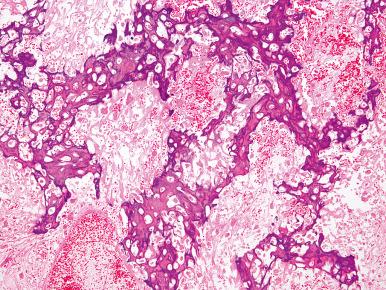
Prognosis. The overall prognosis for osteosarcoma has significantly improved. For many years, the 5-year survival rate fluctuated very little from the figure of 20% in most series. Recently, many reports listing 5-year disease-free rates of 60% or better have appeared. The routine use of multiagent neoadjuvant chemotherapy has had a dramatic positive effect on prognosis; patients with greater than 90% necrosis following chemotherapy generally have a better prognosis than those with less than 90% necrosis.
A variety of other factors, including age, tumor size, stage, location, and surgical margins, have been examined with respect to prognosis. However, the plateau in prognosis has led investigators to look beyond clinical parameters in the hope of discovering improved treatment regimens. Historically, the significance of P-glycoprotein and HER2/neu expression was heavily studied but highly controversial. More recently, expression of p16, the product of the CDKN2A gene, has been shown to correlate with response to chemotherapy and outcome in high-grade localized osteosarcoma.
Enchondromas are relatively common neoplasms that occur over a wide age range. The most common site of origin is the small bones of the hands and feet, and enchondromas are extremely uncommon in flat bones. Enchondromas are non-growing lesions that are asymptomatic and often discovered incidentally during the work-up of other conditions such as arthritis, internal derangement of the knee, rotator cuff tears, or in the evaluation of a patient for metastatic disease.
Enchondromas are composed of lobules of hyaline cartilage, often separated by normal cancellous bone or marrow. The lobules are often bounded by bone (so-called encasement pattern), and endochondral ossification may be present at the periphery of individual lobules ( Fig. 40.25 ). Enchondromas lack invasive properties, differentiating them from low-grade chondrosarcomas. Cytologically, there is significant overlap between enchondromas and low-grade chondrosarcomas, and high-magnification evaluation cannot reliably separate these two entities. Nonetheless, most enchondromas are paucicellular and contain small, pyknotic chondrocyte nuclei. Lesions arising in the small bones of the hands and feet, those occurring in the setting of enchondromatosis, and those in children may appear somewhat more cellular.
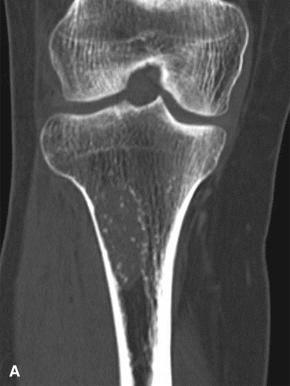
The differentiation of enchondroma from low-grade chondrosarcoma cannot be reliably achieved without radiographic (and clinical) correlation. Enchondromas are typically radiolucent with areas of mineralization that vary from punctate to ring-like. Endosteal scalloping may be seen with both enchondromas and low-grade chondrosarcomas (see later); however, endosteal scalloping associated with cortical thickening is an ominous feature. The most important radiographic features of enchondromas are those that are not present, including extensive bone destruction, cortical destruction, periosteal reaction, and the formation of a soft tissue mass. It is important to understand that the radiographic features that help distinguish enchondromas from low-grade chondrosarcomas in the long bones are not applicable to lesions in the small bones of the hands and feet, in the setting of enchondromatosis, or in skeletally immature patients.
Enchondromas of long bones may be managed by observation alone, whereas those in the hands or feet may require curettage. Biopsy of well-differentiated cartilage tumors is of limited utility, and sampling issues often preclude reliably distinguishing enchondromas and low-grade chondrosarcomas. It should be emphasized that radiographic and clinical features are extremely valuable in separating enchondroma from low-grade chondrosarcoma.
Multiple enchondromas having a predominantly unilateral distribution are referred to as Ollier disease . The association of multiple enchondromas with soft tissue hemangiomas (including spindle cell hemangiomas) is known as Maffucci syndrome ( Fig. 40.26 ). In both of these nonheritable conditions, there is a significant risk of malignant transformation, usually in the form of chondrosarcoma.
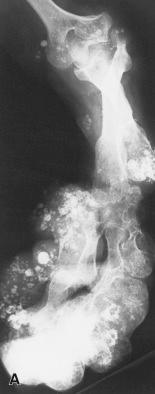
Periosteal (juxtacortical) chondromas are much less common than enchondromas. They arise from the periosteal region of a long bone, often the humerus, or a small bone of the hand or foot. They characteristically erode and induce reactive changes in the underlying cortex. Radiographically, periosteal chondromas are small, circumscribed surface lesions that scallop the underlying cortex and are often accompanied by a buttress of reactive bone at the advancing edges of the lesion.
Microscopically, periosteal chondroma tends to be more cellular than its medullary counterpart and may contain mild atypia ( Fig. 40.27 ).
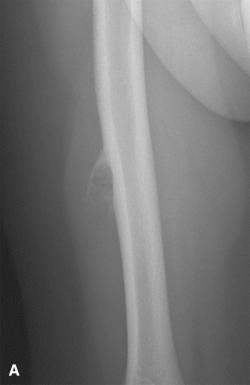
Solitary enchondromas, periosteal chondromas, and the enchondromas of Ollier and Maffucci syndrome have heterozygous mutations in the IDH1/IDH2 genes.
Although not strictly a chondroma, the peculiar chest wall lesion of infancy known as vascular and cartilaginous hamartoma (chest wall hamartoma, mesenchymal hamartoma) is discussed here because of its benign nature and predominant cartilaginous composition. These chondroid areas, which often exhibit endochondral ossification, are mixed with spindled cells forming vascular channels, hemangioma-like foci, and aneurysmal bone cyst-like foci. Most of the cases are already present at birth, and the behavior is benign.
Osteochondroma is one of the most frequently encountered benign bone tumors in surgical pathology. The average age of the patient at onset is approximately 10 years; in the large majority of the cases, the tumor appears before the patient is 20 years old. It is usually asymptomatic, but it may become symptomatic if the stalk fractures, an overlying bursa develops, or if the mass impinges on adjacent neurovascular structures. The most common locations are the metaphyses of the distal femur, proximal tibia, proximal humerus, and pelvis.
Radiographically, osteochondromas have a very characteristic appearance. These exophytic osteocartilaginous lesions can be pedunculated (with a thin stalk) or sessile (with a broad base). The cortical and medullary portions of the osteochondroma stalk merge with the same structures in the underlying bone ( Fig. 40.28 ). These features are easily demonstrated on computed tomography (CT). The cartilage cap of the osteochondroma, best assessed with MRI, seldom exceeds 1 cm, is typically thinner than that, and diminishes as the patient's skeleton matures.
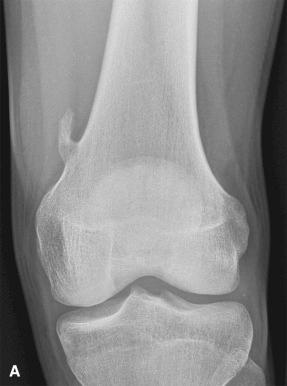
Grossly, the surface of an osteochondroma is covered by a thin layer of fibrous tissue that represents a continuation of the periosteum. The measurable hyaline cartilage cap ranges from a few millimeters to a centimeter in thickness and is often thicker in skeletally immature patients. The surface may appear bosselated in larger sessile osteochondromas. The junction of the cartilage cap and underlying stalk contains calcified cartilage, and the stalk itself is composed of cortical and cancellous bone.
Microscopically, the cartilage cap is composed of hyaline cartilage, and endochondral ossification is evident at the junction of the cap and underlying stalk. The stalk is composed of cortical and cancellous bone ( Fig. 40.29 ). The cap of the osteochondroma actively proliferates until the patient reaches skeletal maturity. In older patients, an osteochondroma may lack a cartilage cap altogether. A bursa may develop around the head of a longstanding osteochondroma; in turn, this bursa may develop complications such as osteocartilaginous loose bodies or synovial (bursal) chondromatosis.
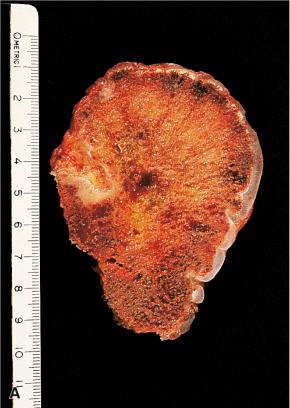
Multiple hereditary exostoses (MHE) is an autosomal dominant condition characterized by multiple osteochondromas that are identical to sporadic osteochondromas. Because there is variable penetrance and expression in this disorder, the number of osteochondromas may vary considerably. In addition to multiple osteochondromas, patients often have modeling defects at the ends of bones and other bone deformities.
MHE is caused by germline mutation in the EXT1 (at 8q24) or EXT2 (at 11p11–12) genes. These genes have been implicated in the formation of both sporadic and hereditary osteochondromas; defects in EXT1 are roughly twice as common as defects in EXT2 .
Secondary chondrosarcomas arise in a very small proportion of solitary osteochondromas, but the incidence reaches 10% in the patients with MHE. The cells in secondary chondrosarcoma are frequently wild type for EXT genes, suggesting that separate genetic alterations are responsible for the malignant conversion.
Osteochondroma should be distinguished from the bizarre parosteal osteochondromatous proliferation (Nora lesion) , which usually involves the small bones of the hands and feet and occasionally in other long and flat bones. These lesions are radiographically distinctive but can simulate chondrosarcoma microscopically because of the presence of enlarged, bizarre, and binucleated chondrocytes. Recurrent chromosomal alterations have been found, suggesting that this condition is of neoplastic nature.
Subungual exostosis (Dupuytren exostosis) is an osteochondroma-like lesion involving the distal phalanx, most commonly located on the great toe. This lesion is histologically similar to bizarre parosteal osteochondromatous proliferation and contains a proliferating cartilaginous cap that merges into relatively mature cancellous bone at its base. These exostoses may recur but are invariably benign. Similar to bizarre parosteal osteochondromatous proliferation, cytogenetic studies have demonstrated a recurrent t(X;6), suggesting this is likely a neoplastic process.
Dysplasia epiphysealis hemimelica (Trevor disease) , a rare developmental disorder of childhood characterized by asymmetric enlargement of the epiphyseal cartilage of long bones, is yet another condition that can mimic osteochondroma.
Osteochondromyxoma is a rare recently described congenital neoplasm associated with lentigines and other extraskeletal disorders; the syndrome seems to represent a variation of the Carney complex.
Chondroblastoma occurs predominantly in skeletally immature patients under 20 years of age and can be quite painful. It usually arises in the epiphysis or apophysis of long bones prior to skeletal maturity, particularly in the distal femur, proximal humerus, and proximal tibia.
Radiographically, chondroblastoma usually appears as a sharply circumscribed radiolucent lesion and may contain small foci of mineralization. MRI typically shows extensive perilesional edema. From the epiphysis, it may extend into the metaphyseal area or the joint space. Rarely, it is found entirely in a metaphyseal location or in a small bone.
Microscopically, this lesion may be confusing because of its extreme cellularity and variability. The occasional scattered collections of giant cells may lead to an erroneous diagnosis of giant cell tumor ( Fig. 40.30 ). The basic tumor cell is the chondroblast with only a limited capacity for the production of a cartilaginous matrix. The shape of this cell is usually epithelioid, although spindle elements can also be present. Chondroblasts have sharply circumscribed cytoplasmic borders, and the nuclei vary in shape from round to indented and lobulated; some resemble those of Langerhans cells with a prominent longitudinal nuclear groove. Mitoses are not prominent. Recurrent lesions may show some degree of atypia, a feature that should not be interpreted as a sign of malignant transformation. A distinctive microscopic change is the presence of small zones of calcification. The calcifications range from a network of thin lines (“chicken wire”) to obvious deposits surrounded by giant cells. The cartilaginous matrix in chondroblastoma often has an immature, eosinophilic appearance, and hyaline cartilage is uncommon. Secondary aneurysmal bone cyst is present in a significant number of chondroblastomas.

Immunohistochemically, the cells of chondroblastoma coexpress vimentin and S-100 protein. They may also be immunoreactive for SOX9, low-molecular-weight cytokeratins, p63, neuron-specific enolase, and muscle-specific actin.
Recently, it has been shown that chondroblastomas have distinctive driver mutations in the genes that encode histone H3.3. Chondroblastomas harbor mutations in the H3F3B gene far more commonly than the H3F3A gene. An antibody directed against the H3F3 K36M mutation has been found to be specific for chondroblastoma.
The diagnosis is possible on the basis of fine-needle aspiration material, which in a typical case will consist of neoplastic chondroblasts, multinucleated osteoclast-like giant cells, and chondroid matrix fragments. Curetting with bone grafting, which is the preferred treatment, provides local control in over 80% of the cases. Local recurrences can be treated similarly.
Several cases of chondroblastoma, microscopically indistinguishable from the rest, have behaved locally in an aggressive fashion, invading the soft tissues and developing tumor thrombi in angiolymphatic channels. Most of these aggressive tumors have been located in the pelvis. A few others have given rise to distant metastases, usually to the lungs. In nearly all of the reported cases of this phenomenon, the metastases have occurred after surgical manipulation of the primary tumor.
Become a Clinical Tree membership for Full access and enjoy Unlimited articles
If you are a member. Log in here